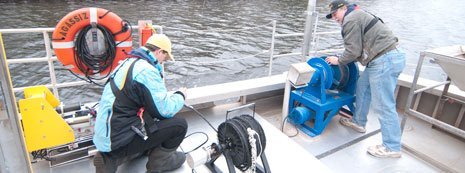Title
Estimation of interstitial velocity using a direct drive high resolution passive profiler
Document Type
Article
Publication Date
2-27-2019
Abstract
The fate and transport of groundwater contaminants depends partially on groundwater velocity, which can vary appreciably in highly stratified aquifers. A high resolution passive profiler (HRPP) was developed to evaluate groundwater velocity, contaminant concentrations, and microbial community structure at ~ 20 cm vertical depth resolution in shallow heterogeneous aquifers. The objective of this study was to use mass transfer of bromide (Br‐), a conservative tracer released from cells in the HRPP, to estimate interstitial velocity. Laboratory experiments were conducted to empirically relate velocity and the mass transfer coefficient of Br‐ based on the relative loss of Br‐ from HRPP cells. Laboratory‐scale HRPPs were deployed in flow boxes containing saturated soils with differing porosities, and the mass transfer coefficient of Br‐ was measured at multiple interstitial velocities (0 to 100 cm/day). A 2D quasi‐steady‐state model was used to relate velocity to mass transfer of Br‐ for a range of soil porosities (0.2‐0.5). The laboratory data indicate that the mass transfer coefficient of Br‐, which was directly – but non‐linearly – related to velocity, can be determined with a single 3‐week deployment of the HRPP. The mass transfer coefficient was relatively unaffected by sampler orientation, length of deployment time, or porosity. The model closely simulated the experimental results. The data suggest that the HRPP will be applicable for estimating groundwater velocity ranging from 1 to 100 cm/day in the field at a minimum depth resolution of 10 cm, depending on sampler design.
Publication Title
Groundwater
Recommended Citation
Schneider, H. A.,
Jackson, W. A.,
Rainwater, K.,
Reible, D.,
&
Morse, S.
(2019).
Estimation of interstitial velocity using a direct drive high resolution passive profiler.
Groundwater.
http://doi.org/10.1111/gwat.12874
Retrieved from: https://digitalcommons.mtu.edu/cee-fp/81


Publisher's Statement
Publisher's version of record: https://doi.org/10.1111/gwat.12874